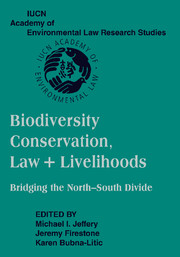 Biodiversity Conservation, Law and Livelihoods: Bridging the North-South Divide
Biodiversity Conservation, Law and Livelihoods: Bridging the North-South Divide Book contents
- Frontmatter
- Contents
- Acknowledgments
- Message from Kofi A. Annan, Secretary-General of the United Nations
- Macquarie Statement
- Contributors
- Introduction
- PART ONE THE CONTEXT
- PART TWO BIODIVERSITY: ITS CONSERVATION
- PART THREE CONSERVATION MEASURES
- PART FOUR USES OF COMPONENTS OF BIODIVERSITY
- PART FIVE PROCESSES AFFECTING BIODIVERSITY
- PART SIX BIOSECURITY ISSUES
- PART SEVEN ACCESS AND BENEFIT-SHARING
- Index
Introduction
Published online by Cambridge University Press: 31 July 2009
- Frontmatter
- Contents
- Acknowledgments
- Message from Kofi A. Annan, Secretary-General of the United Nations
- Macquarie Statement
- Contributors
- Introduction
- PART ONE THE CONTEXT
- PART TWO BIODIVERSITY: ITS CONSERVATION
- PART THREE CONSERVATION MEASURES
- PART FOUR USES OF COMPONENTS OF BIODIVERSITY
- PART FIVE PROCESSES AFFECTING BIODIVERSITY
- PART SIX BIOSECURITY ISSUES
- PART SEVEN ACCESS AND BENEFIT-SHARING
- Index
Summary
The threats to biological diversity are well known, and include overharvesting of flora and fauna, species introductions, habitat loss and fragmentation, pollution, tourism, globalization, and climate change. These factors threaten the sustainability of culture as well. This volume, addressing as it does the conservation of biodiversity and the divide between developed and developing states, appropriately focuses international and comparative environmental law scholars, practitioners, and policy makers on ways to engage cooperatively to meet the broader imperatives of a sustainable biosphere and sustainable cultures. It also usefully ties these concepts together in one volume given the interrelationship between the two. The tension between nature conservation, on the one hand, and sustainable cultures, on the other, is perhaps best reflected in international law by section 8(j) of the 1992 Convention on Biological Diversity (CBD). There states are called on to conserve biological diversity and to “respect, preserve, and maintain” indigenous cultures while at the same time promoting the wider sustainable use of the components of biological diversity. Appropriately, the Convention recognizes that the conservation of biological diversity is a “common concern of humankind.” We would suggest that sustainable cultures should likewise be recognized. It is to these twin goals – rather, obligations – that we now turn.
This book places the issues threatening biological diversity – the variability of life on Earth and their interaction at the level of genes, species, and ecosystems – in a contemporary context.
- Type
- Chapter
- Information
- Biodiversity Conservation, Law and Livelihoods: Bridging the North-South DivideIUCN Academy of Environmental Law Research Studies, pp. 1 - 6Publisher: Cambridge University PressPrint publication year: 2008
- 2
- Cited by
